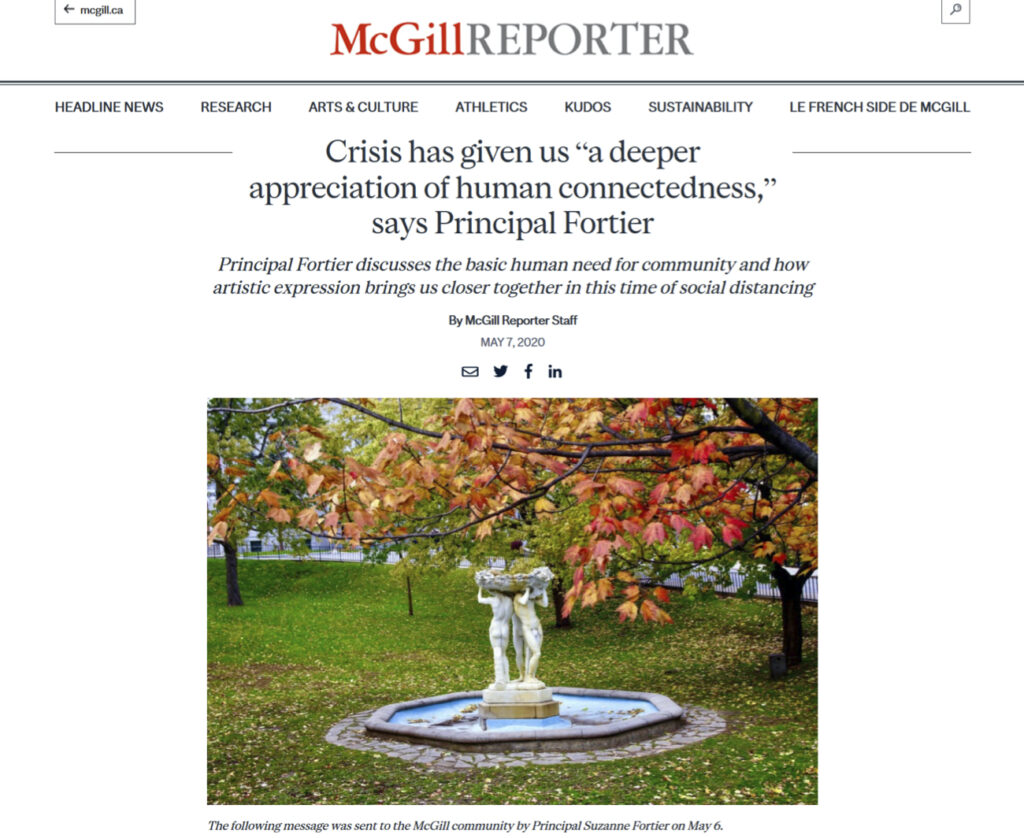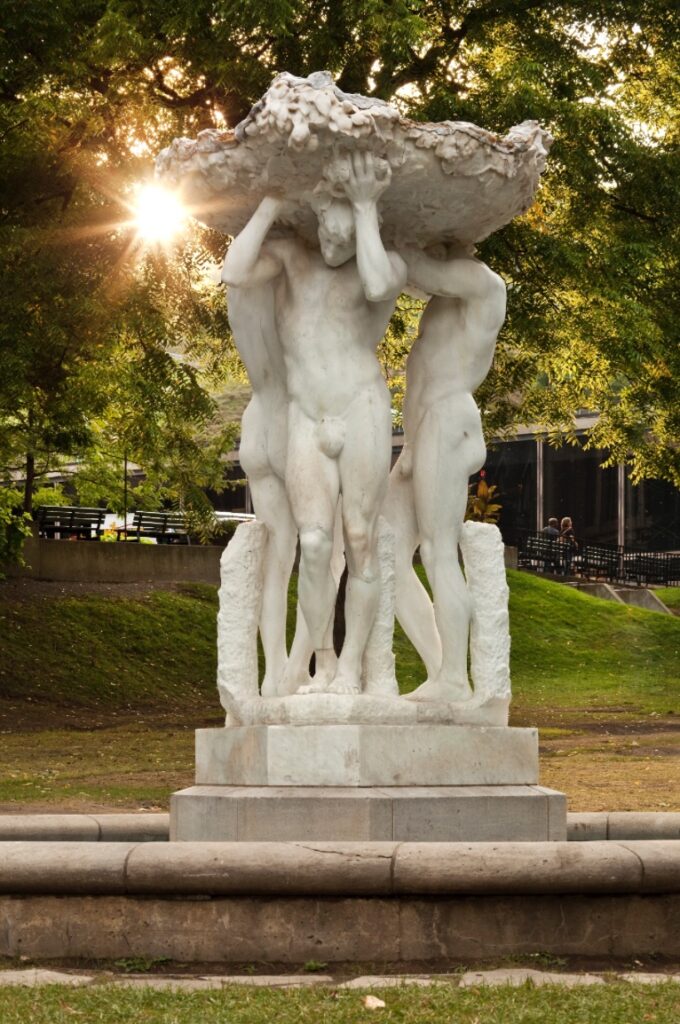By Gwendolyn Owens, Director, McGill Visual Arts Collection
In this moment of great stress and uncertainty, most of us have found wisdom, relief, or simply solace in words, in music, or in art that has survived for generations. The Friendship Fountain at the heart of McGill’s lower campus has proved a good reminder of the enduring power of art to connect us to each other.
Last spring, the University used a sentimental photograph of Gertrude Vanderbilt Whitney’s Friendship Fountain on lower campus to illustrate an upbeat online message from Principal Suzanne Fortier about how she turns to the arts in moments of stress. Set against a background of autumn leaves, the University’s own classical sculpture of three men holding up a shell, seemed to be silently waiting for us to come back. The latest news tells us that next fall we will all be back on campus.

In this moment of great stress and uncertainty, most of us found wisdom, relief, or simply solace in words, in music, or in art that has survived for generations. These things remind us that disasters have happened before and that humanity (or some version of it) has gotten through it. On campus now for 90 years, the sculpture, affectionately nicknamed The Three Bares, has become a fixture despite the fact that it is more like what you would find in a European town square than at an institution of higher learning. For many people– including the Principal–it has become a symbol of the persistence and survival of the arts.
Created by Gertrude Vanderbilt Whitney, an artist better known now as the founder and benefactor of the Whitney Museum of American Art in New York, the sculpture was commissioned for the lobby of a new hotel in Washington, D.C. It was modelled in France and exhibited at the Paris Salon of 1913 where it was given honourable mention.
The hotel in question was never built and the sculpture, which is actually a fountain, languished in the artist’s New York studio until coming to McGill as a symbol of friendship between the U.S. and Canada. In an elaborate ceremony in May 1931, in the midst of another crisis when the Depression threatened the future of the University, dignitaries came together to celebrate its unveiling. A British flag and an American flag were lifted with a flourish to reveal the sculpture hidden beneath. There was nothing literal in the symbolism of the sculpture, no finger stretching across borders, no handshake; it was simply art. Since then, it has witnessed countless events–from pubs to theatrical performances–and likely been photographed almost more than anything else on campus. The sculpture has become a symbol of McGill, akin to a secret handshake that only those who have been to the campus know about, as it has no literal association with scholarship or Canada.

Right now, that lack of association is a strength. Unlike statues of founders or benefactors of an institution or government leaders, classical sculptures of mythic figures are not seen as taking sides in political or religious issues. The three men in this sculpture together hold up a heavy burden that requires continuous cooperation and endurance, rain or shine, summer or winter. Their message can be read as the importance of not giving up. Or it can be read as beauty remains always. Or one can simply remember having a drink by the sculpture or a conversation with a friend. We get to give it whatever meaning we choose, and we can’t wait to see it again.
Read more about it on the VAC website.
Célébration des contacts humains : amitié autour d’une fontaine
Par Gwendolyne Owens, directrice, collection d’arts visuels de McGill
En cette période de grand stress et d’incertitude, la plupart d’entre nous trouvent sagesse, réconfort ou bien refuge dans les mots, la musique ou l’art qui perdurent depuis des générations. L’œuvre intitulée The Friendship Fountain, située sur le campus inférieur de McGill, s’est révélée un excellent rappel du pouvoir impérissable de l’art pour nous aider à établir des liens les uns avec les autres.
Le printemps dernier, l’Université a choisi une photographie sentimentaliste de l’œuvre de Gertrude Vanderbilt Whitney intitulée The Friendship Fountain et située sur le campus inférieur pour illustrer un message encourageant diffusé en ligne par la principale Suzanne Fortier, qui explique qu’elle trouve du réconfort dans l’art durant les périodes stressantes. Sur un fond de feuilles d’automne, la sculpture classique de l’Université qui représente trois hommes tenant un coquillage semble attendre en silence que nous revenions à elle. Aux dernières nouvelles, nous devrions tous réintégrer le campus à l’automne.

En cette période de grand stress et d’incertitude, la plupart d’entre nous trouvent sagesse, réconfort ou bien refuge dans les mots, la musique ou l’art qui perdurent depuis des générations. Tout cela nous rappelle que les catastrophes n’ont rien de neuf et que l’humanité (ou une mouture de celle-ci) s’en est toujours sortie. Installée sur le campus depuis maintenant 90 ans, la sculpture, affectueusement surnommée Les trois nus, fait maintenant partie du paysage, bien qu’il s’agisse d’une œuvre qu’on s’attend plus à trouver sur la place publique d’une ville d’Europe pas sur le terrain d’un établissement d’enseignement supérieur. Pour beaucoup de gens – dont la principale –, elle est devenue un symbole de la pérennité et de la survivance des arts.
Sculptée par Gertrude Vanderbilt Whitney, une artiste mieux connue comme la fondatrice et la bienfaitrice du Whitney Museum of American Art de New York, l’œuvre d’art devait à l’origine orner le hall d’un nouvel hôtel à Washington, D.C. Cela a été créé en France et exposée au Salon de Paris en 1913, à l’occasion duquel on lui a attribué une mention honorable.
L’hôtel en question n’a jamais été construit et la sculpture, qui est en fait une fontaine, se languissait à New York dans l’atelier de l’artiste avant d’être donnée à McGill comme symbole d’amitié entre les États-Unis et le Canada. À l’occasion d’une grande cérémonie qui s’est déroulée en mai 1931, en plein cœur de la Grande Dépression, une autre crise qui menaçait l’avenir de l’Université, des dignitaires se sont réunis pour célébrer son dévoilement. Un drapeau britannique et un drapeau américain ont été soulevés avec panache pour révéler la sculpture qu’ils recouvraient. Il n’y avait rien de littéral dans le symbolisme de la sculpture : pas de main tendue à travers une frontière ni poignée de mains; il s’agissait simplement d’une œuvre d’art. Depuis, la statue a été témoin d’innombrables événements – des soirées pub jusqu’aux représentations théâtrales -, et elle est probablement l’objet le plus photographié sur le campus. Elle est devenue un symbole de McGill que seuls ceux qui sont venus sur le campus connaissent, un peu comme une poignée de mains secrète, puisqu’elle n’a au sens strict aucun lien avec les bourses d’études ni avec le Canada.

À l’heure actuelle, cette absence d’association est une force. Contrairement aux statues de fondateurs ou de bienfaiteurs d’un établissement ou de chefs politiques, les sculptures classiques qui représentent des figures mythiques ne sont pas perçues comme prenant parti dans les débats politiques ou religieux. Les trois hommes soutiennent ensemble un lourd fardeau qui exige continuellement coopération et endurance de leur part, beau temps, mauvais temps, été comme hiver. On peut en comprendre qu’il ne faut jamais abandonner. Ou que la beauté est éternelle. Ou se rappeler la fois qu’on a bu un verre ou conversé avec un ami aux côtés de la sculpture. On peut lui donner le sens qu’on veut, et il nous tarde de la revoir.
Lisez plus sur le site web de la collection d’arts visuels de McGill













Leave a Reply
You must be logged in to post a comment.